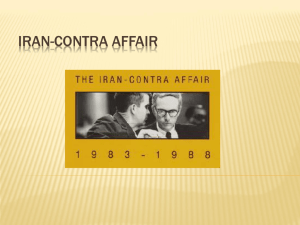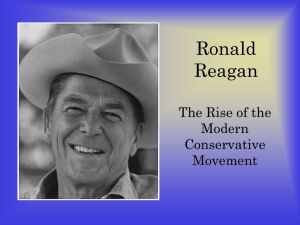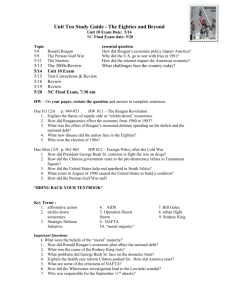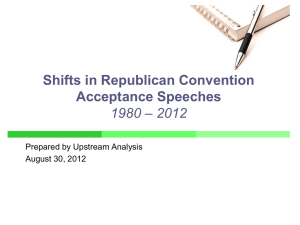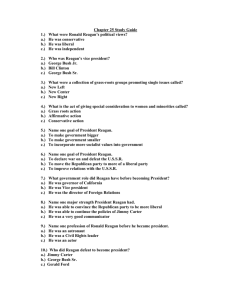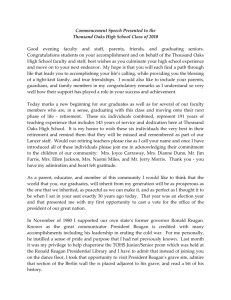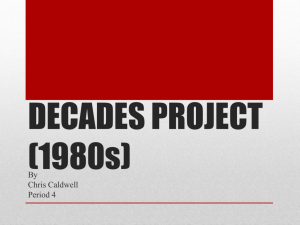Chapter 40
advertisement
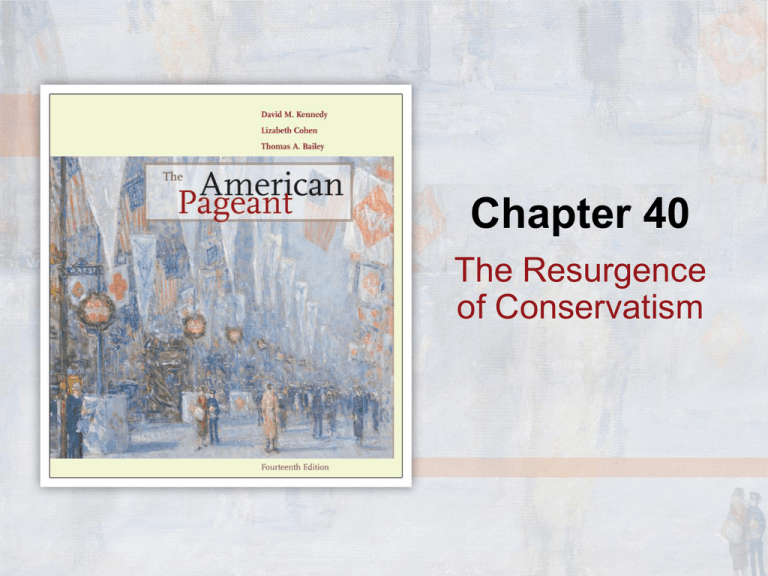
Chapter 40 The Resurgence of Conservatism President Ronald Reagan Older than any man previously elected to the presidency, Reagan displayed youthful vigor both on the campaign trail and in office. Presidential Election of 1980 (with electoral vote by state) This map graphically displays Reagan’s landslide victory over both Carter and Anderson. Coming Home After more than a year in captivity in Iran, these hostages were released on the very day of Ronald Reagan’s presidential inauguration. The Triumph of the Right, 1980 Republican conservatives scored a double victory in 1980, winning control of both the White House and the Senate. Aided by conservative Democratic “boll weevils,” they also dominated the House of Representatives, and a new era of conservatism dawned in the nation’s capital. Wallflowers Reagan’s budget cuts fell almost exclusively on social programs, whereas military outlays increased substantially. Star Wars Fantasies President Reagan’s Strategic Defense Initiative (popularly known as Star Wars) evoked extravagant hopes for an impermeable defensive shield, but its daunting physical and engineering requirements also occasioned much ridicule in the scientific community. The Middle East A combination of political instability and precious petroleum resources has made the region from Egypt to Afghanistan an “arc of crisis.” Central America and the Caribbean This region, so important to the United States throughout its history, remained a hotbed of unrest through the last years of the Cold War and beyond. East Meets West President Reagan greets Soviet leader Mikhail Gorbachev at a summit meeting in Moscow in May 1988. Contra Rebel Troops Head for Battle These rebels were long-seasoned and battle-scarred veterans of Nicaragua’s civil war by the time this photograph was taken in 1987. The National Debt, 1930–2006 World War II provided the first major boost to the national debt. But it was the policies of the Reagan and George H. W. Bush administrations, 1981–1993, that explosively expanded the debt to the $4 trillion level. By the 1990s, 14 percent of federal revenues went to interest payments on the debt. The budget surpluses created by the booming economy of the second Clinton administration (1997– 2001) raised the prospect that the debt might be paid off. But the combination of the George W. Bush tax cuts and increased military spending sent the debt soaring again after 2001. Sources: Historical Statistics of the United States and Statistical Abstract of the United States, relevant years; Office of Management and Budget, “Mid-Session Review: Budget of the U.S. Government, Fiscal Year 2008.” Share of Income Received by Families, by Quintile, 1980–2005 Since 1980 the incomes of the lowest 20 percent and the middle 60 percent have been shrinking, while the incomes of the highest 20 percent, and particularly the top 5 percent, have climbed steadily. Source: Statistical Abstract of the United States, 2008. The Moral Majority, 1981 Television evangelist and religious leader the Reverend Jerry Falwell mobilized his national Moral Majority organization in support of Ronald Reagan’s presidential campaign in 1980 and a conservative social agenda. The Justice Is a Lady, 1981 Herblock hails Sandra Day O’Connor’s appointment to the Supreme Court. George Herbert Walker Bush (b. 1924) Campaigning, October 1988 Bush soundly defeated Democratic candidate Michael Dukakis in the November 1988 election. Tiananmen Square, Beijing, China, June 1989 The Chinese communist state mobilized all its forces against students demonstrating for a more democratic China. Fallen Idol Romanians toppled this statue of Vladimir Lenin in 1990, symbolically marking the collapse of the Marxian dream that had agitated the world for more than a century. The End of the Cold War Changed the Map of Europe The Agony of Yugoslavia, 1992 These Bosnian refugees from the town of Jajce illustrate the plight of millions of Yugoslavians as their country slid into vicious interethnic battles in the wake of the Cold War’s conclusion. The Highway of Death The allied coalition wreaked gruesome destruction on Iraqi forces fleeing back to Iraq after their defeat in Kuwait in 1991. Operation Desert Storm: The Ground War, February 23–27, 1991 Read My Nose When President Bush reneged on his 1988 campaign promise of “no new taxes,” he inflicted mortal political damage on his reelection campaign in 1992.



